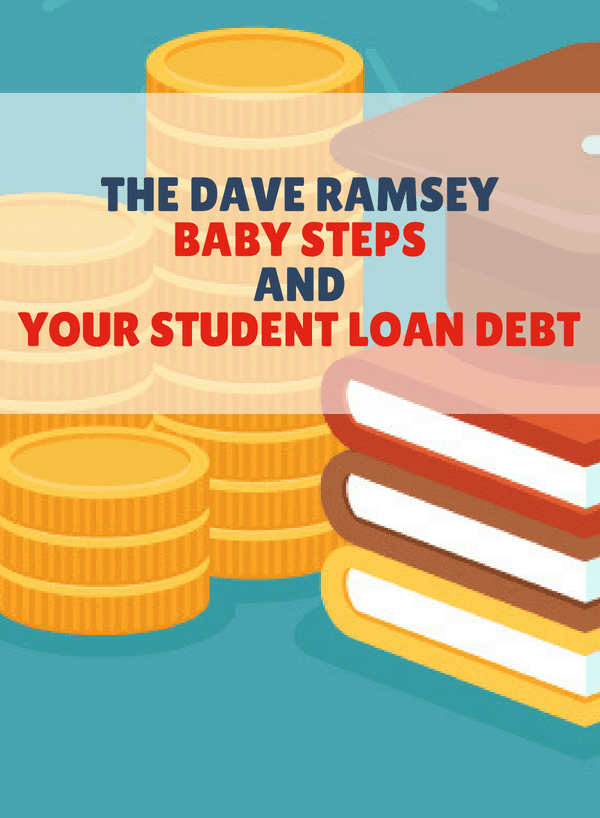
Despite being one of the most controversial figures in the personal finance space, Dave Ramsey has probably inspired more people to pay off debt than anyone else around. His absolute hatred of debt inspires followers to become “gazelle intense” as they focus on debt repayment.
You might not like his style, but you cannot deny the effectiveness of his approach. If you have student loans, this is what you should know about Dave Ramsey’s “baby step” approach to getting out of debt.
The Budget and Gazelle Intensity
When it comes to getting out of debt, the average American has to get two things on their side (at least according to Dave Ramsey). They need their budget and their emotions working for them.
The baby step approach is all about intense focus on a single mission. Ramsey urges listeners to become gazelle intense about the first two baby steps. “Gazelle intense” refers to working at a sprint pace rather than a marathon pace. Most people who follow the program become consumer debt-free in just two or three years, and eliminate their mortgage within seven years.
If you choose the baby step approach, I recommend pairing it with the intensity that Ramsey suggests. Letting paying off debt drag on for more than a few years is a recipe for never paying off debt.
Of course, people don’t just need emotion, they need a budget to keep their spending in line. Ramsey suggests a zero-sum budget to help keep you on track. I agree. Without a spending plan, the debt payoff plan won’t work. We have several resources on how to budget here on The College Investor. Over time, you can probably evolve to a less time intensive budget tracking method, but creating a budget is key when you’re getting started.
Baby Step One: Get a $1,000 Emergency Fund
The first step in Dave Ramsey’s plan is to get together a $1,000 emergency fund. This can simply be a $1,000 buffer in your checking account.
Most people earning a median income should be able to get a $1,000 emergency fund in place within a single month. The easiest way to get this in place is to sell some big ticket items and to cut out obvious expenses like daily lattes and eating out.
Is $1,000 Enough?
A lot of people criticize the $1,000 emergency fund saying it's not big enough. The fact of the matter is that half of Americans can’t come up with $400 without selling something or tapping into credit cards.
$1,000 is enough money to get you through a car repair or a minor health problem. Plus, the number is small enough to get in place within a few weeks. It’s good to have a quick win right off the bat.
What If I Expect a Big Bill in the Future?
The one caveat to the $1,000 emergency fund is if you’re expecting a big bill in the near future. For example, if you’re having a baby, you’ll probably pay several thousand dollars in medical costs. If you expect a layoff, you don’t want to be caught without some savings.
Do what you can to be sure you have enough to cover upcoming expenses without taking on more debt.
Baby Step Two: Pay Off Your Debts in Order of Smallest to Largest
Once you have $1,000 banked, it’s time to start the debt repayment plan. Ramsey advises paying off your debts from smallest balance to largest using the debt snowball.
Using the debt snowball, you’ll make minimum payments on all your debts except the debt with the smallest balance. Every extra dollar you have in the budget will go toward the smallest debt. When you pay off the smallest debt, you take the minimum payment from that debt and put it toward the next debt. This goes on until you’ve paid off all your debts (except a mortgage).
This method doesn’t take into account interest rates, bankruptcy, or loan consolidation options, but in many cases, that doesn’t matter. The goal is to get rid of debt so fast that the interest rate doesn’t matter much. If you have a very high debt-to-income ratio, this plan might not work for you.
Should I Get on an Income-Driven Repayment Plan?
One of the common questions about student loan repayment is whether to get on an income-driven repayment plan. Dave Ramsey generally doesn’t like the plans because they scare people into earning less money.
My take is that you should get on an income-driven repayment plan, but use it as a crutch only as long as you need it. Your top priority in debt repayment needs to be increasing your income, so you have more money to throw at debt. Income-driven repayment plans will help you with cash flow while you work on the income side of the equation.
Plus, new income-driven repayment plans like SAVE will include student loan forgiveness for borrowers, which is fantastic. You don't want to pay extra on this plan!
What About Student Loan Forgiveness?
Public Service Loan Forgiveness is another one of Ramsey’s constant punching bags. He hates it and discourages listeners from relying on it, even if they have several years of service under their belts. Personally, I’ve seen several friends use PSLF and other loan forgiveness programs to get rid of debts.
I can’t say with 100% confidence that the programs will be around in 10 years, but I think if they get disbanded they will have a phaseout period, and typically existing borrowers are grandfathered in. If you plan to qualify for PSLF, enroll in the program, and don’t aggressively repay your student loan debts. Instead, put as little as you can toward the debts and as much as you can toward your investments. If PSLF doesn’t work out, you can hopefully liquidate investments to pay off the loans. If it does work out, then you did the right thing.
Should I Consolidate?
Consolidating student loans is often a helpful option for people looking to extend repayment time or to simplify their lives. Unfortunately, consolidating student loans means you no longer have a smallest and largest balance loan. That means you lose the satisfaction of little wins along the way.
For most people, I would avoid consolidating student loans except if you can refinance to a lower interest rate (with no origination fees).
Related: What If I Have Old FFEL Loans?
What If I'm Facing Bankruptcy?
If you’re facing bankruptcy, the baby step plan probably isn’t working out for you. I would recommend continuing to make minimum payments on your student loans as those will probably survive the bankruptcy. Stop making payments on all unsecured debts such as credit cards or personal loans.
Remaining Baby Steps
Once you’ve eliminated all your debts, it’s time to move on to Dave Ramsey’s other steps. Here they are in order.
Baby Step Three: Build an Emergency Fund of Three to Six Months of Expenses
Once you’re debt free, you should use your money to build up cash reserves. At this point, Dave Ramsey still advises skipping on investing (even up to your employer match). Accumulating three to six months of expenses in an emergency fund can take up to a year to build, so I tend to temper this advice a bit. Invest up to an employer match while focusing the rest of your funds to a cash reserve.
Baby Step Three (Part B): Buy a House with a 20% Down Payment
A lot of people on Dave Ramsey’s plan already own houses once they start paying off debt. However, if you don’t own, Ramsey recommends putting 20% down on the house. He also recommends waiting until you have a solid emergency fund in place before you buy a house.
Baby Step Four: Put 15% Toward Retirement
Once you have your emergency fund in place, Ramsey finally recommends starting to invest. His starting place is 15% towards retirement in a diversified portfolio of mutual funds. If you’re able to put more than 15% toward a savings goal, Ramsey advises to put excess funds toward steps five and six.
Baby Step Five: Save for Kids' College
If you have kids and you’re contributing at least 15% of your income toward retirement, it’s time to start saving for kids' college expenses. Hopefully, you can use the middle and high school years to help your kids prepare for college financially, so they can avoid loans themselves.
Related: How To Save For College
Baby Step Six: Pay Off House Early
If you have extra money (after 15% toward the house, and money toward college), it’s time to pay off the house. Amazingly, even with other goals, most people who follow Dave Ramsey’s plan manage to pay off their house in seven years. My sister and her husband have used this plan, and they are now on track to eliminate their mortgage before their sons finish high school.
Baby Step Seven: Build Wealth and Give Generously
The last baby step is sort of a generic catch-all for do whatever you want. Once you’ve laid the foundations of the first six baby steps, you’re probably in a great position to start some more interesting forms of investing such as real estate investing or starting a personal business. It’s also a reminder to give to others as you have opportunity.
Is the Dave Ramsey Plan Right for Your Student Loans?
The baby steps make a ton of sense for average student loan borrowers. While the baby steps aren’t the financially smartest (for example, forgoing a 401(k) match during debt repayment makes no sense), they are emotionally appealing. If you don’t have a plan to pay off your debt, start with Dave Ramsey’s baby steps. You might find something better, but the Dave Ramsey plan will get you excited and moving in the right direction.

Robert Farrington is America’s Millennial Money Expert® and America’s Student Loan Debt Expert™, and the founder of The College Investor, a personal finance site dedicated to helping millennials escape student loan debt to start investing and building wealth for the future. You can learn more about him on the About Page or on his personal site RobertFarrington.com.
He regularly writes about investing, student loan debt, and general personal finance topics geared toward anyone wanting to earn more, get out of debt, and start building wealth for the future.
He has been quoted in major publications, including the New York Times, Wall Street Journal, Washington Post, ABC, NBC, Today, and more. He is also a regular contributor to Forbes.
Editor: Clint Proctor Reviewed by: Chris Muller
